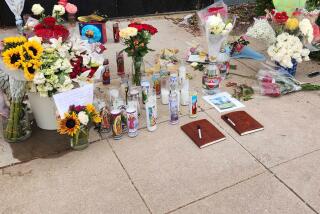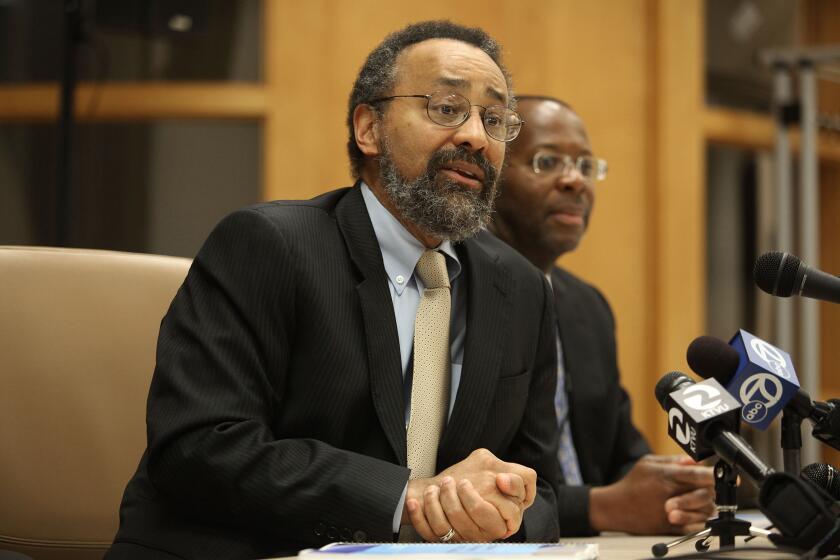Fire Duty: Watcher in a Hot, Dry Wind
Al Chard is one of the Orange County Fire Department’s experts in uncovering fire hazards in large businesses and warehouses.
So why was he assigned Monday to a seemingly endless Sunday drive through the east county countryside?
He was there because atop the ocean of air over Nevada a swell had developed, much like a swell at sea. The weight of that swell was pushing air below it toward the nearest low-pressure area, one over northernmost Baja California.
And along its way, the air was being forced through Southern California canyons. Like air being pushed through a tire pump, the winds were emerging from the canyons faster, hotter and dryer than when they went in.
Early Arrival
They’re the annual Santa Ana winds, and the first big one arrived Monday, earlier than usual, to make your skin dry out and your hair crackle when you comb it and your hand spark when you reach for a doorknob.
But their most awesome effect is one of a huge, natural hair dryer that parches the already dry grass and brush of the canyons and hillsides, converting it to tinder. That threat prods the county Fire Department to send inspectors like Al Chard into the backcountry in hopes that they can prevent a fire from breaking out. Three were out on patrol Monday.
“Basically, we look for people in the wildland areas and let them know they shouldn’t be there. We also log the license numbers of abandoned or parked or suspicious cars in case a fire breaks out sometime later nearby,” Chard said as he drove his car through Silverado, Modjeska and Santiago canyons east of Orange. Most of that mountainous land is closed to the public during fire season.
‘He Just Didn’t Think’
Chard also pays close attention to the residents of the area, the people one would expect to be most careful about fire.
“You’d be surprised what people will do when the wind is blowing,” Chard said. “Once in a 40- or 45-mile-an-hour wind we found a guy who was welding on the bridge to his house. There were sparks flying pretty good. He just didn’t think. He wrapped it up right away as soon as we talked to him.
“The people who live here who have seen the fires, they’re pretty careful. It’s the new ones who moved up here because they wanted horses. They haven’t lived through one.”
Those who have know the Santa Ana winds’ potential. Most of the wildland fires are set intentionally or accidentally by people, firefighters say. But once they’re set, the winds take over. In 1980, the winds fanned three separate, major fires through Orange County within 28 days. The last one was the climax: a 28,200-acre fire in northeast Orange County that burned seven buildings, injured three firefighters and destroyed $7 million worth of watershed.
Wind gusts as powerful as 60 m.p.h. intensified the flames. It took 1,241 firefighters--hand crews from as far as the East Coast and fire engine crews from as far as San Francisco--to extinguish the blaze. That fire, like the previous two, had been intentionally set, fire investigators concluded.
Logging a License Number
Chard, who had driven to the top of a ridge near Modjeska Canyon, could see dry, brown hillsides in almost all directions.
“Basically, we’re here to be visible and let people know we’re watching,” he said.
Along Santiago Canyon Road, Chard stopped to inspect a dilapidated car parked on the shoulder. “I’ll just log the license number and make sure nobody’s hiding inside,” he said.
The car had a note tucked under its windshield wiper: “Please don’t tow away. I am down the ravine and up the other side. Will be back by 4 p.m.!” The location described was posted land closed due to fire hazard.
Chard spotted the man standing atop a distant ridge, his right hand occasionally rising to his mouth. “He’s smoking,” Chard said. He shouted to the man, asking him to come down.
He turned out to be a 23-year-old from Garden Grove who said he had hiked in to sit in solitude and write a letter to his father. He said he did it because they wanted to charge a fee to get into a nearby county park. Where he comes from, you don’t have to pay to go into parks, he said. He admitted he had cigarettes in his pocket.
Chard sent him on his way without citing him. “I don’t come up here to be a cop,” he said. “If people don’t cooperate and I need some enforcement, I call for some.”
Back in the car, Chard conceded that the patrol duty is mostly dreary work. Shifts often are 10 or 11 hours long and “get kinda boring and lonesome at times,” he said.
On the other hand, the patrols could be doing much good, he said. Chasing the smoker off the ridge might have prevented a catastrophic fire, he said, “but there’s really no way you can tell.”
More to Read
Start your day right
Sign up for Essential California for news, features and recommendations from the L.A. Times and beyond in your inbox six days a week.
You may occasionally receive promotional content from the Los Angeles Times.






